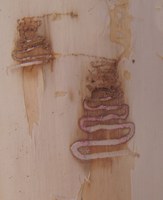Dakota Gardener: Emerald ash borer revisited
(Click an image below to view a high-resolution image that can be downloaded)
By Joe Zeleznik, Forester
NDSU Extension
Do you remember what you had for lunch on February 10, 2023? Surprisingly, I do remember. It was a ham and cheese sub sandwich.
I remember because I got a text message during lunch, from a colleague who had found emerald ash borer (EAB) in Moorhead, Minnesota.
I didn’t finish my lunch that day.
Over the next two months, dozens of people from at least five different government agencies scoured the Fargo-Moorhead metro area, searching for more EAB-infested trees. We found a few in Dilworth and another couple in Moorhead, but none in Fargo. It wasn’t for lack of trying.
It’s now been over 15 months since that first find. What’s happened since then?
There’s been a lot of additional searching by a number of people, and we still haven’t found it in North Dakota. More infested trees were found in both Dilworth and Moorhead though.
We’ll keep searching in North Dakota. Let’s face it – the Red River is not going to stop this insect.
“The find” attracted a lot of attention locally and brought the issue to the forefront. City foresters in our local communities have been working for several years to reduce the percentage of ash trees in the urban forest. Fargo is at about 22%, and that’s down from the 40% that the city had in 2010 when they first began diversification efforts.
Moorhead has about the same percentage of ash trees on its boulevards and in its parks. That’s more than 6,000 public trees that are in a high-risk situation. EAB is deadly to ash trees.
Fortunately, we’re still in the “build-up” phase of the infestation, and there’s time to act. The city foresters in these areas are using a combination of treatments and removals (with replacements) to minimize risk and spread out costs, all while increasing diversity of the urban forest. It is a good strategy.
Individual homeowners are making management decisions as well. Some people have decided to have their trees treated as a preventative measure. Others have already removed their ash trees and are working on replacements. Again, both are good options.
Some people are taking a wait-and-see approach. That’s okay, at least for a while, but I hope people don’t wait too long. When ash trees die, they quickly become brittle and they’re very dangerous to remove, and very expensive.
My wife and I live about 35 miles from the nearest known infestation, so we have a little extra time to decide. We’re pretty sure that we’ll get rid of one of our ash trees and treat the other one. I planted a Kentucky coffeetree a few years ago near the one tree that we’re planning to remove. Someday, it’ll make a nice replacement. For now, it’s little more than a stick!
Treatments are incredibly effective at preventing damage from EAB. Our general recommendation is to hold off on treatments until EAB has been found within 15 miles of your location. So, most homeowners in North Dakota have a lot more time to decide. Nevertheless, it’s time to pay attention.
An individual EAB insect generally doesn’t travel very far in its lifetime, usually to the next ash tree. They can fly up to about 10 miles, if they need to. What we really worry about, though, is their spread via firewood. It takes less than a day to move firewood to any location in North Dakota and the region. That’s one of my biggest concerns.
So, we still have some time to prepare. What’s your plan for your own ash trees? Does your community have a plan?
Now’s the time to prepare. Don’t wait.
NDSU Agriculture Communication – May 16, 2024
Source: Joe Zeleznik, 701-730-3389, joseph.zeleznik@ndsu.edu
Editor: Kelli Anderson, 701-231-7006, kelli.c.anderson@ndsu.edu




